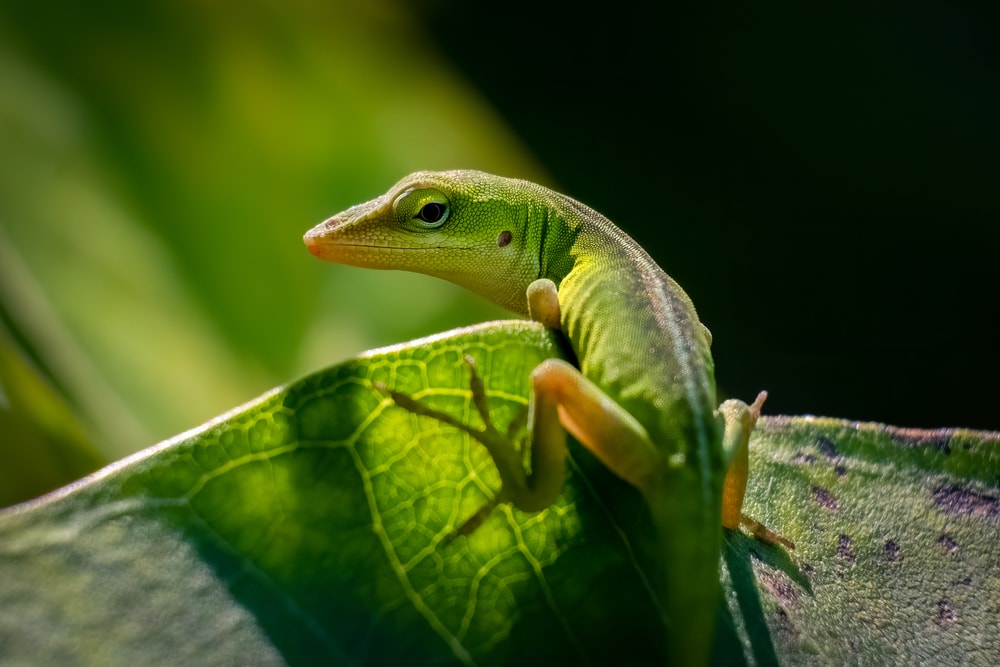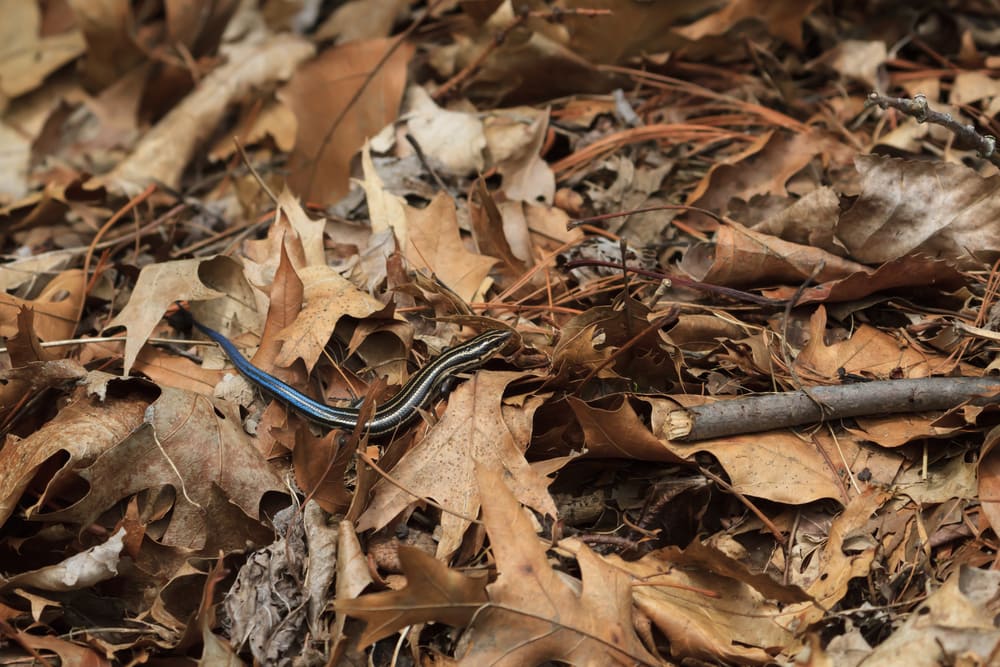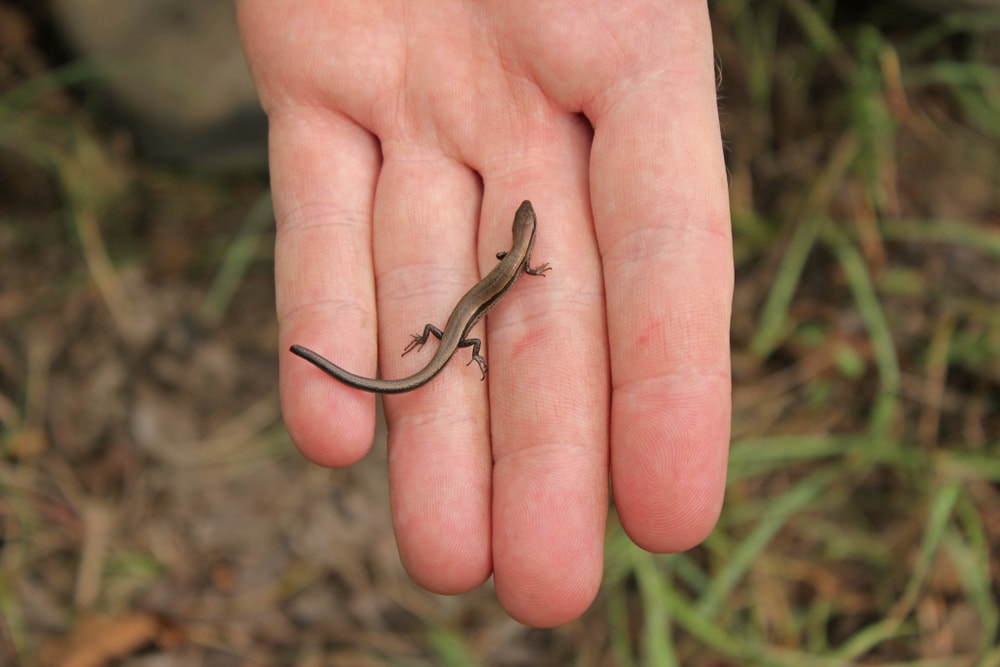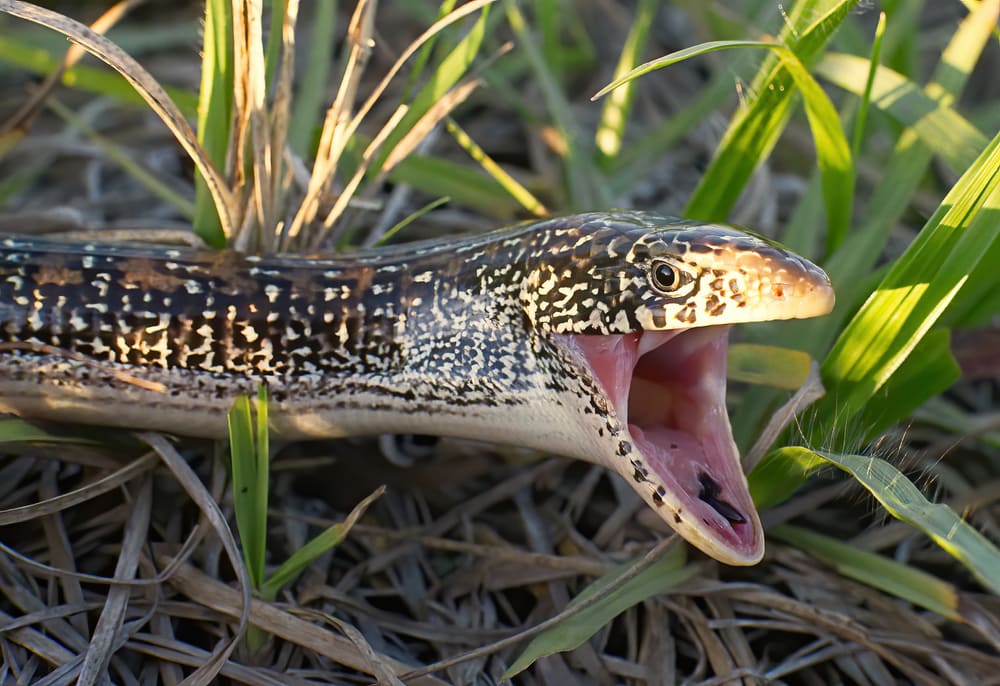
North Carolina is home to 12 species of lizards; however, there is an invasive species that can be referred to as the 13th species. There is high chance of coming across one around your home if you live in this state. Lizards interestingly serve as both predators and prey in the same ecosystem.
As predators, North Carolina’s lizards control the number of insects and pests in the ecosystem and as prey offer a food source to birds, snakes, and raccoons. Keep reading to learn more about all the different species of lizards in North Carolina.
North Carolina Lizards Fun Facts


Share this image on your site
<a href="https://outforia.com/lizards-in-north-carolina/"><img style="width:100%;" src="https://outforia.com/wp-content/uploads/2022/03/lizards-in-north-carolina-infographic-1-683x1024.jpg"></a><br>lizards in north carolina <a href="https://outforia.com">Outforia</a>12 Species of North Carolina Lizards
1. Texas Horned Lizard (Phrynosoma cornutum)



Description
The Texas horned lizard is perhaps the easiest to recognize lizard in North Carolina because of the prominent horns at the back of its head and two more on its side. The two rows of spiky scales on the sides of the Texas horned lizard make this beautiful creature appear fiery looking to most people. However, despite its look, the creature is harmless.
This feature distinguishes it from other horned lizards. An adult Texas horned lizard can grow up to 8.89 – 12.7 cm or 3.5 – 5 inches.
The lizard has a variety of colors including; red, brown, or gray with dark marking that serves as a form of camouflage.
Life Cycle
This species of North Carolina lizards have an average lifespan of about five years in the wild but can live beyond that if taken in as a pet. The Texas horned lizard is largely a docile, diurnal, and solitary animal; hence, it only interacts during mating season which starts in mid-April and ends in mid-June.
Diet
The Texas horned lizard is mainly an insectivore; hence, it primarily feeds on ants, termites, beetles, and grasshoppers.
Predators
Predators of the Texas horned lizard are dogs, wolves, coyotes, and birds.
Habitat
The Texas horned lizard lives largely in arid and semi-arid regions with access to some open grounds and scattered vegetation. It is found in dunes, deserts, and prairies. The Texas horned lizard is also prey to other larger animals and can dig, dart away, puff up to appear larger, or camouflage to escape from predators.
Range
The Texas horned lizard is found in the south-central United States and northern Mexico. In the U.S, they are found around North Carolina, Texas, New Mexico, and Oklahoma.
2. Green Anole (Anolis Carolinensis)



Description
Green anoles are largely arboreal animals, mostly found on tree branches. Though they are called Green anoles, however, they can change their color to gray, yellow, or brown depending on the humidity or temperature of their environment and the level of activity levels, stress levels, or mood. A mature adult measures up to 20.32 cm or 8 inches in size.
Life Cycle
The Green anole lizard has a lifespan of about 2 to 3 years in the wild while the green anole in captivity can live up to 8 years. Males during mating display beautiful pink or red dewlap to entice females or to chase out rivals during territorial rivalry. Like other lizards, they lay eggs.
Diet
The green anole feeds heavily on spiders, flies, ants, crickets, moths, worms, and termites.
Predators
The predators of this species of snakes include; cats, dogs, snakes, and birds.
Habitat
The Green anoles are diurnal animals and usually bask in the sun when they are not hunting or fighting for dominance. They are arboreal animals and can be found nearly everywhere apart from mountainous areas.
Range
The Green anole is found throughout Georgia and some parts of Carolina.
3. Eastern Fence Lizard (Sceloporus Undulatas)



Description
The eastern fence lizard is either grayish or brownish with keeled pointed scales. The male species of this lizard has more uniformed wavy lines on their back than their female counterparts. The male eastern fence lizard also has greenish-blue coloration on its throat and the sides of its belly, especially during summer.
The eastern fence lizard is a medium-size animal and averages a size of 10.16 cm or 4 inches in length and can grow up to a maximum length of 19.05 cm or 7.5 inches.
Life Cycle
The average lifespan isn’t clearly understood but scientists estimate less than five years. Like other lizards, they lay eggs. They hatch the eggs after incubation. Gestation lasts for about 8 weeks in late spring or early summer while Incubation lasts between 8 – 10 weeks.
The hatchlings are usually between 3 – 16. They are also polygynous which allows one male to mate with more than one female during the breeding season.
Diet
The eastern fence lizard feeds on ants, beetles, spiders, moths, ladybugs, stink bugs, and grasshoppers.
Predators
The eastern fence lizard is preyed on by cats, dogs, snakes, larger lizards, and birds.
Habitat
They are found in different habitats with temperate climates around mountains, shrublands, grassland, forest, and rocky areas. They are classified as animals with the least concern because of their stable population.
Range
The eastern fence lizards are found in northern Florida, North Carolina, Ohio, Arkansas, and New York.
4. Coal Skink (Plestiodon anthracinus)



Description
Life Cycle
Among coal skinks, the mating season starts in late spring or early summer and the females lay between 4 to 7 eggs in damp soil and guard them till they hatch into little lizards. The coal skink can live up to an average of 6 years in the wild and up to 10 years in captivity.
Diet
The coal skink preys on arthropods like the earthworm and termite.
Predators
The coal skinks are preyed on by raccoons, crows, herons, hawks species, bigger lizards, and snakes.
Habitat
The coal skinks are found in humid regions, rocky areas, near springs, and wooded hillsides.
Range
The coal skinks are found in mountainous areas of northern Georgia, North Carolina, and western South Carolina and a small distinctive area of western Georgia.
5. Five-lined Skink (Plestiodon fasciatus)



Description
This species of North Carolina lizards got its name from five equal-width, yellow, or cream stripes on its body. The mature males of the five-lined skink develop reddish-orange coloration on their snout and jaws during mating season while the juveniles have blue tails that fade into green, brown, or gray as they age.
A mature adult averages the length of about 12.7 cm or 5 inches and can reach the maximum size of about 21.59 cm or 8.5 inches if conditions are favorable. The adult male five-lined skinks are territorial and fend off other males aggressively from their territories.
Life Cycle
Five-lined skins can live up to an average of 6 years in the wild and up to 10 years when in the zoo or when kept as a pet. This lizard lays between 6 – 10 eggs in nests.
Diet
They feed primarily on insects including; roaches, crickets, grasshoppers, and arthropods like spiders.
Predators
The five-lined skinks are susceptible to birds, cats, and snakes. A distinctive defensive mechanism in the five-lined skinks is the ability to detach its tail to evade capture.
Habitat
This species of North Carolina lizards prefer partially or moist wooded regions with areas for basking. Hence, you can find them in stumps, logs, abandoned buildings, and brush piles.
Range
They are found in places like Michigan, New York, Florida, Ontario, Texas, North Carolina, Missouri, and Kansas.
6. Southeastern Five-lined Skink (plestiodon inexpectatus)

Description
The southeastern five-lined skink, like the five-lined skink, has five light stripes on its back and a narrow middle stripe that differentiates it from other species of lizards in North Carolina.
The adult males of the southeastern five-lined skink develop orange-brown coloration on the head during the breeding season while the juveniles have bright blue tails that fade as they age. The southeastern five-lined skink has climbing skills but spends most of its time on the ground. The adult averages the size of 14 cm or 5.5 inches and may reach a maximum length of 21.59 cm or 8.5 inches.
Life Cycle
The southeastern five-lined skink can live up to six years in the wild and up to 10 years in captivity. Like other species of North Carolina lizards, it lays eggs, guards the nest, and watches them hatch.
Diet
The diets of the southeastern five-lined skink are spider species, insects, and other invertebrates.
Predators
The southeastern five-lined skink is preyed on by hawks, kestrels, shrikes, raccoons, cats, snakes, opossums, moles, skunks, shrews, and crows.
Habitat
The typical habitats of the southeastern five-lined skink are dry, sandy, arid environments, or wooded regions.
Range
South Carolina, North Carolina, and Georgia.
7. Six-lined Racerunner (Aspidoscelis sexlineatus)



Description
This species of North Carolina lizards is remarkable for two attributes. First, it has six stripes on its back. Secondly, it has an impressive speed and can easily clock 29 km or 18 miles in one hour when threatened.
An adult can grow up to 24.13 cm or 9.5 inches. The six-lined racerunner has a slim body and long tail. They can have black, brown, or olive coloration with velvet skin.
Life Cycle
The breeding season starts in late April through to July and the female lays up to six eggs. But, unlike the five-lined skink, this species of lizard does not protect its eggs.
Diet
Like most North Carolina lizards, the six-lined racerunner feeds on a wide variety of insects, spiders, and other insects.
Predators
This species of lizard has the snake as its main predator.
Habitat
This species of lizards live in dry, open areas with little vegetation or loose soil. They hide under rocks, creeks, and pools, and may burrow in the ground to hide from predators.
Range
Although common in North Carolina, they are found in Maryland, Texas, Florida, Minnesota, Wisconsin, and North Carolina.
8. Broad-headed Skink (Plestiodon laticeps)



Description
The broad-headed skink is one of the largest lizards in North Carolina. Its large size and labial scales differentiate it from other skinks in North Carolina. The adult skinks have a variety of colors that includes; olive-brown, gray, black, or brown. An adult of this species can reach 33 cm or 13 inches in length.
Life Cycle
The broad-headed skink can live up to four years in the wild and up to eight years in captivity. Like other lizards, it lays eggs. They lay their eggs under logs or sawdust piles.
Diet
It feeds on beetles, grasshoppers, cockroaches, and earthworms.
Predators
Predators
It is preyed on by cats, birds, and larger reptiles.
Habitat
They are found easily in swamps, forests, and even abandoned buildings.
Range
They are found throughout Georgia, South, and North Carolina.
9. Little Brown Skink (Scincella lateralis)



Description
As the name suggests, this is the smallest species of lizard in North Carolina alongside with the Texas horned lizard. It measures an average of 7.62 cm or 3 inches and has a dark stripe running along its sides. The coloration of the little brown skink ranges from black to golden brown and coppery brown depending on its habitat and the belly can be yellow or white.
Life Cycle
The average lifespan of the little brown skink is between two to three years and like other skinks lay eggs. It lays between 1-5 eggs in rotten logs or soil mounds.
Diet
The brown skink feeds on insects, isopods, and spiders.
Predators
The predators of this species of lizard include birds, wolf spiders, cats, shrews, skunks, larger lizards, and armadillos.
Habitat
They are not arboreal; hence, they don’t climb. Instead, they reside in areas with abundant leaf critters and loose soil. With a preference for staying away from climbing trees, they are also referred to as ground skinks.
Range
They are found in New Jersey, Ohio, Indiana, Florida, Kansas, Texas, and North Carolina.
10. Slender Glass Lizard (Ophisaurus attenuates)



Description
The slender glass lizard is easily mistaken for a snake by most people because unlike most lizards in the state, it is legless. However, it does glide on its stomach like the snake; instead, it glides and pushes its body in a sideways motion. This feature sets it apart from other North Carolina lizards.
Again, it can close its eyes as it has external ear openings for sound. A mature member of this species can grow up to 107 cm or 42 inches.
Life Cycle
The slender glass lizard is the longest living among all the other North Carolina lizards. It has a lifespan of 10 – 30 years and lays eggs for reproduction like other lizard species.
Diet
This species of lizards feed on nearly everything that fits into its mouth including; insects, crickets, beetles, small lizards, and grasshoppers.
Predators
Predators of the slender glass lizard include; hawks, raccoons, snakes, birds of prey, and other carnivorous mammals.
Habitat
The slender glass lizard inhabits places such as pine/oak barrens, prairies with tall grasses, open woodlands, and sandy or well-drained soils.
Range
It’s found in Georgia, South, and North Carolina.
11. Eastern Glass Lizard (Ophisaurus ventralis)



Description
The eastern glass lizard also resembles snakes and just like the slender glass lizard, they are limbless, are the biggest species of lizards that call North Carolina home, they have external ear openings, moveable eyelids, and inflexible jaws.
These long, slender, and limbless North Carolina lizards have unique coloration that includes; light brown, yellowish, or greenish, and unlike other species of glass lizards found in North Carolina, they lack a dark dorsal stripe on their back. A mature male can grow up to an average of 107 cm or 42 inches.
Life Cycle
The eastern glass lizard can live up to 10 years and like other species of lizards lay eggs.
Diet
The diet of the eastern glass lizards includes insects, arthropods, and small invertebrates. The eastern glass lizard is also known to feed on insects, spiders, snails, smaller lizards, small rodents, and small snakes.
Predators
The eastern glass lizards are, in turn, food for raccoons, hawks, and snakes.
Habitat
The eastern glass lizard is a diurnal animal, but males are generally more active. They are often found in open woodlands, pine forests, and southern coastal plains.
Range
They find their range in the eastern and southern portions of Georgia, South, and North Carolina.
12. Mimic glass lizard (Ophisaurus mimicus)

Description
This is one of the species that call North Carolina home. The mimic glass lizard is widely known for its brown coloration with a black or dark brown mid-dorsal stripe. Interestingly, there are three to four dark stripes above the lateral groove of this lizard.
They are diurnal but the males are more active than the females and they can reach a maximum length of 66.04 cm 26 inches in a favorable condition but usually an average length of 38.1 cm or15 inches.
Life Cycle
The mimic glass lizard, like other lizards, reproduces by laying eggs and can live up to an average of 10 years in the wild.
Diet
The mimic glass lizard finds food in insects, snails, raccoons, small snakes and lizards, and small rodents.
Predators
Predators of this species of lizards are raccoons, snakes, birds of prey, and opossums.
Habitat
They are known to live in open woodlands, pine forests, and southern coastal plains.
Range
The mimic glass lizard exists on the coasts of South Carolina and Southern Georgia. They are also found in North Carolina.
You may also like: Check out the 28 Different Types of Lizards in Florida: Complete with Images, Facts, and More!
Invasive Species
The 13th species of lizard found in North Carolina is an invasive species and is worth our mention because it isn’t just an invasive species it is also the most commonly seen lizard in the state.
13. Mediterranean House Gecko (Hemidactylus turcicus)



Description
The Mediterranean house gecko is some of the most invasive lizard species in North Carolina and their color range from white to gray or brown with some touch of pink or purple undertone. The adult can grow up to an average of 10 cm and sometimes 15 cm.
The Mediterranean house geckos are widely known for their large lidless eyes and sticky toe pads. The Mediterranean house gecko also has dark mottling and bumps on its skin. The belly of the Mediterranean house gecko is translucent.
Life Cycle
The Mediterranean house geckos can live up to an average of five years and their mating season starts from March to July. The female Mediterranean house gecko lays between 3 to 6 eggs a year and then hides them in trunk cracks, moist soil, or under stones. The incubation period lasts between one to three months for the Mediterranean house gecko.
Diet
The Mediterranean house gecko feeds on insects, spiders, moths, and other smaller lizards. It is mostly nocturnal and is easily drawn to outdoor light while searching for its prey.
Predators
The predators of this species of North Carolina lizards like in other species are snakes, birds, and larger lizards.
Habitat
The Mediterranean house geckos enjoy habitats with high humidity and warm temperatures. They are climbing animals and can be found easily on tree barks, cracks, and inside walls in houses in nearly every part of the world.
Range
This species of lizard is one of the most successful lizards in the world and as its name implies is native to the Mediterranean region of the world. The Mediterranean house gecko is found around countries with Mediterranean climates like Portugal, Spain, France. In the U.S it is known to the states of California, Florida, Mississippi, Ohio, New Mexico, Alabama, North Carolina, Texas, and Utah.
You may also like: Learn More About the 36 Lizards You Can See in California: With Images, Facts, and More!
FAQ About North Carolina Lizards

Are North Carolina lizards poisonous?
The quick answer is no. There are no poisonous lizards in North Carolina; hence, you don’t have anything to fear about these beautifully patterned creatures.
Do lizards move around at night?
The vast majority of lizards are diurnal. That is to say that they are active only during the day. However, there are a few species that are nocturnal and active at night.
How do lizards survive winter?
Like other reptiles, lizards are cold-blooded animals; hence, need the environment to maintain their temperature. Most lizards live in warm environments and few lizards live in cooler areas. They undergo brumation during the winter. Their metabolism during brumation slows to the point where it looks like they are dead.








